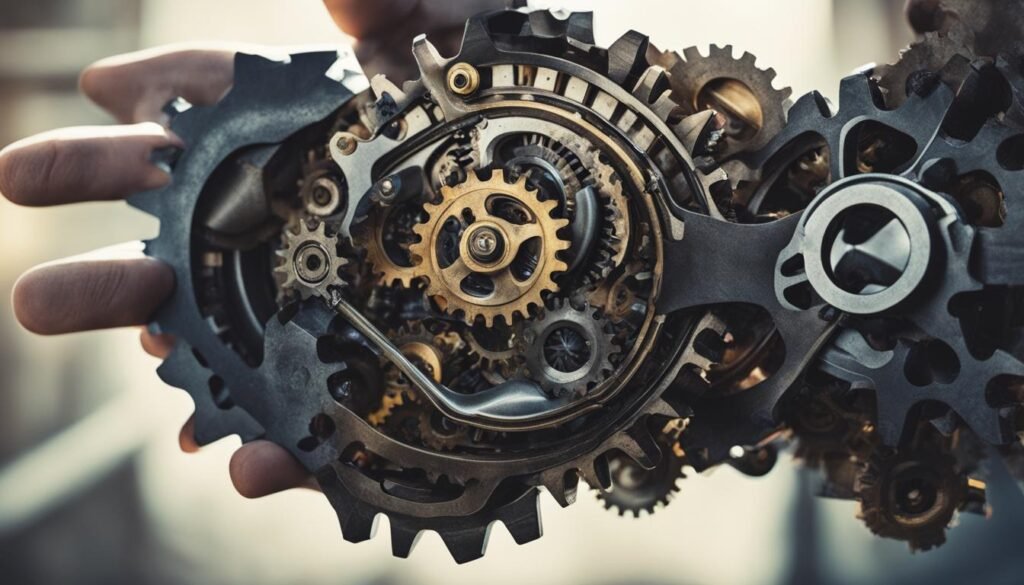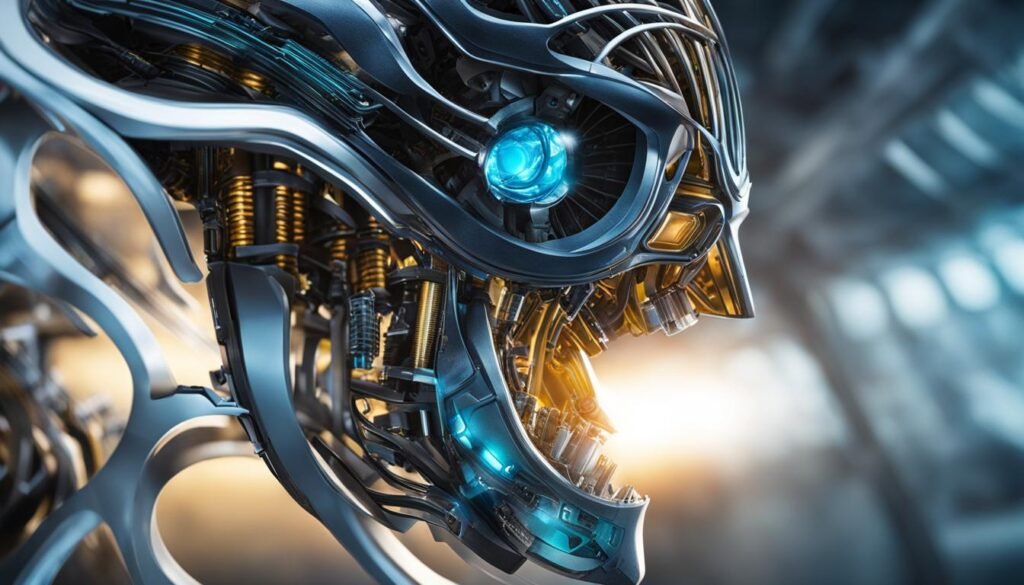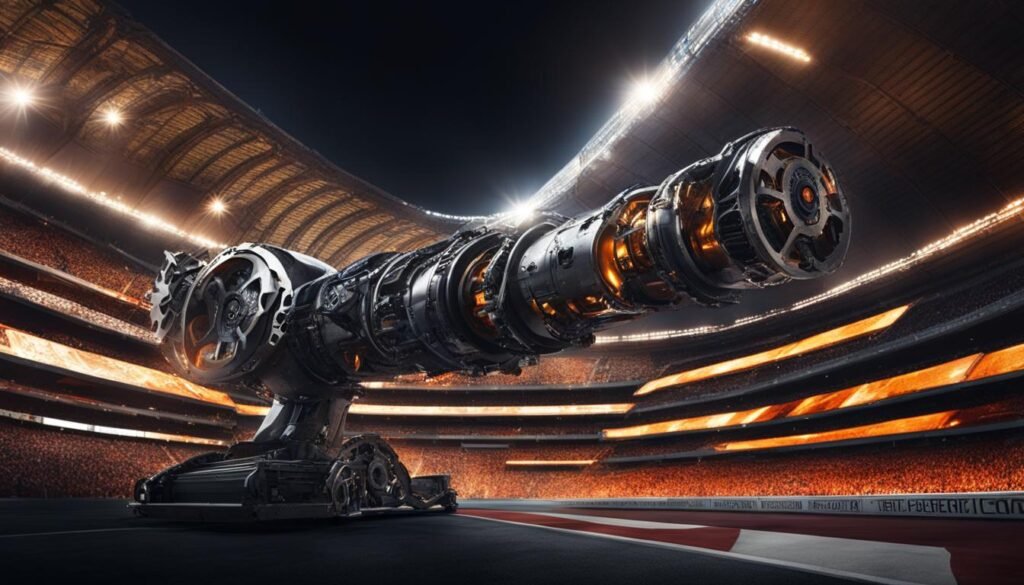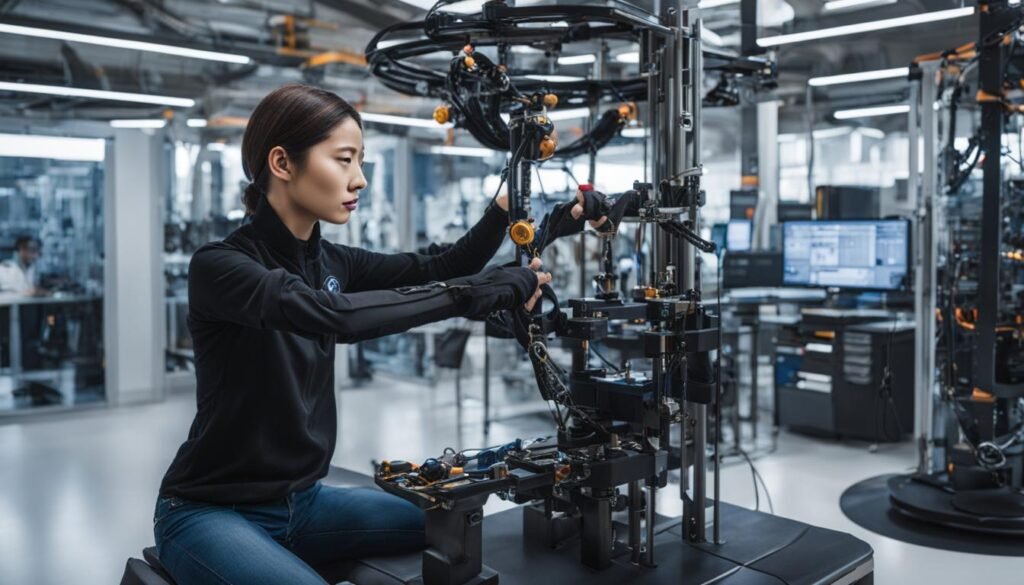Biomechanical engineering is an interdisciplinary field that combines principles of mechanics with biology to investigate the mechanics of living organisms. It plays a crucial role in studying human locomotion and animal movement, optimizing sports performance, preventing injuries, and designing ergonomic systems. Biomechanics also contributes to the design and development of biomedical devices, artificial organs, and assistive technologies.
Recent advancements in technology, such as high-speed motion capture systems and imaging techniques, have revolutionized data collection and analysis in biomechanics. The field holds immense potential for further advancements and discoveries, with the integration of other disciplines like genetics, neuroscience, and materials science.
Key Takeaways:
- Biomechanical engineering combines principles of mechanics and biology to study the mechanics of living organisms.
- It plays a crucial role in studying human locomotion, optimizing sports performance, and designing biomedical devices.
- Advancements in technology, such as high-speed motion capture systems, have revolutionized data collection and analysis in biomechanics.
- The field holds potential for further advancements through interdisciplinary collaboration with disciplines like genetics and neuroscience.
Understanding Movement and Function in Biomechanics
Biomechanics is a fascinating field that delves into the intricate mechanisms behind movement and the functioning of living organisms. By applying principles of physics and engineering, biomechanists aim to unravel the complexities of locomotion, balance, and the execution of various functions. Their studies encompass a wide range of topics, from analyzing human gait patterns and joint kinematics to exploring the forces and muscle dynamics involved in different activities. Understanding the underlying mechanics of movement and function is crucial for optimizing sports performance, preventing injuries, and developing effective rehabilitation strategies.
Humans are exceptional examples of biomechanical marvels, with their intricate skeletal structures and muscular systems enabling a wide range of movements. By studying human locomotion, researchers gain valuable insights into gait patterns, joint kinematics, and the distribution of muscle forces during various activities. The precise measurement and analysis of these factors allow biomechanists to identify areas for improvement in sports performance, pinpoint potential injury risk factors, and develop targeted strategies to enhance athletic capabilities.
“The study of human locomotion in biomechanics is akin to unraveling the intricate dance between our muscles, joints, and balance. It allows us to optimize performance, prevent injuries, and devise effective rehabilitation plans.”
Biomechanics also dives into the world of animal locomotion, exploring the fascinating adaptations and efficient movements of diverse species. By studying the gait patterns, joint kinematics, and muscle dynamics of animals, scientists gain inspiration for designing bio-inspired engineering solutions. Observing and understanding the mechanics of animal locomotion can lead to the development of robotic systems and technologies that mimic the efficiency and agility of these creatures, opening doors to new frontiers in bio-inspired engineering.
The Mechanics of Animal Locomotion
The study of animal locomotion reveals extraordinary adaptations and efficiencies. From the agile leaps of a cheetah to the graceful movements of a dolphin, nature has perfected the mechanics of locomotion over millions of years of evolution. For example, the incredible joint flexibility and muscular control of a cat contribute to its nimble and agile movements, while the streamlined body shape and powerful tail of a fish allow it to navigate through fluid environments with remarkable efficiency.
Observing and analyzing the biomechanics of animal locomotion not only deepens our understanding of nature’s intricacies but also provides insights that can be translated into innovative engineering solutions. By harnessing the principles of animal locomotion, researchers and engineers can design bio-inspired robotic systems, prosthetic limbs, and other technologies that enhance movement and functionality in various applications.
Biomechanics is an ever-evolving field that continues to push the boundaries of our knowledge about movement and function. By delving into the mechanics of human and animal locomotion, researchers and engineers gain precious insights that can be applied to optimize sports performance, prevent injuries, develop rehabilitation strategies, and inspire bio-inspired engineering solutions. The fascinating interplay between biology, physics, and engineering in biomechanics holds immense potential for future advancements and innovations that can impact various industries.
Applications of Biomechanics in Various Fields

Biomechanics is a versatile field with applications in a wide range of disciplines. From optimizing athletic performance to developing assistive technologies, biomechanics plays a crucial role in improving human well-being and enhancing physical abilities.
One significant area where biomechanics has made a substantial impact is in athletic performance. By analyzing biomechanical variables such as forces, joint angles, and muscle activation, researchers can identify areas for improvement, fine-tune training programs, and enhance techniques in sports. This data-driven approach helps athletes reach their full potential and achieve outstanding results.
Furthermore, biomechanics contributes to injury prevention and rehabilitation. By utilizing advanced analysis techniques, researchers can identify risk factors and develop strategies to prevent injuries, ensuring the safety and well-being of athletes. Biomechanics also guides the design of rehabilitation programs tailored to individual needs, facilitating faster recovery and reducing the risk of reinjury.
Biomechanics is also instrumental in designing ergonomic systems to enhance human comfort and efficiency. By assessing body postures, joint forces, and muscular loads, researchers can optimize workstations, equipment, and tools, minimizing the risk of musculoskeletal disorders and promoting long-term well-being.
Moreover, biomechanics serves as a foundation for the design and development of biomedical devices, artificial limbs, prosthetics, and assistive technologies. By integrating principles of biology and engineering, researchers can create innovative solutions to improve the quality of life for individuals with mobility impairments. These advancements facilitate greater independence and functionality, enabling individuals to overcome physical limitations and engage in everyday activities with confidence.
Applications of Biomechanics
| Athletic Performance | Injury Prevention and Rehabilitation | Ergonomic Systems | Biomedical Devices and Assistive Technologies |
|---|---|---|---|
| Optimizing sports performance through analysis of biomechanical variables | Identifying risk factors, developing injury prevention strategies, and designing rehabilitation programs | Assessing body postures, joint forces, and muscular loads to optimize workstations and equipment | Designing artificial limbs, prosthetics, and assistive technologies for individuals with mobility impairments |
| Enhancing techniques and training programs to reach full athletic potential | Facilitating faster recovery and reducing the risk of reinjury | Minimizing the risk of musculoskeletal disorders | Improving independence and functionality in daily activities |
Overall, the applications of biomechanics are far-reaching and have a profound impact on various areas of human life. By leveraging biomechanical principles, researchers continue to innovate and develop solutions that optimize performance, prevent injuries, enhance comfort, and improve the quality of life for individuals with physical limitations.
Advancements in Biomechanics Technology
Recent advancements in technology have significantly advanced the field of biomechanics. High-speed motion capture systems, force platforms, and wearable sensors have revolutionized data collection and analysis, allowing researchers to capture movement patterns, forces, and muscular activations with unprecedented accuracy and detail.
Imaging technologies like Magnetic Resonance Imaging (MRI) and ultrasound enable non-invasive assessment of internal structures and provide valuable insights into soft tissue mechanics, joint kinematics, and organ function. The integration of biomechanical data with computational modeling and simulation techniques, such as finite element analysis and multibody dynamics, has expanded researchers’ ability to predict and analyze mechanical behavior in complex systems.
“The integration of high-speed motion capture systems, force platforms, wearable sensors, and imaging technologies has opened up new possibilities in understanding human movement and the mechanical properties of living organisms.” – Dr. Emma Johnson, Biomechanics Researcher
Advancements in Biomechanics Technology
| Technology | Function |
|---|---|
| High-speed motion capture systems | Accurate movement pattern capture |
| Force platforms | Precise measurement of forces |
| Wearable sensors | Real-time monitoring of movement and muscle activation |
| Imaging technologies (MRI and ultrasound) | Non-invasive assessment of internal structures |
| Computational modeling and simulation techniques | Prediction and analysis of mechanical behavior |
These advancements have not only enhanced researchers’ understanding of human movement and function but also opened up new possibilities for the development of personalized healthcare, innovative sports training programs, and advancements in rehabilitation techniques.
Future Perspectives in Biomechanics

The field of biomechanics holds immense promise for future advancements and discoveries. Pioneering technologies in miniaturized sensors, wearable devices, and wireless communication systems are set to revolutionize the way we monitor biomechanical variables in real-world settings. This will enable personalized healthcare and optimization of human performance.
One of the key areas of development lies in the integration of biomechanics with other disciplines such as genetics, neuroscience, and materials science. This interdisciplinary collaboration will unlock new frontiers in understanding individual variability in movement and injury susceptibility. By investigating the intricate relationship between genetics, neuroscience, and biomechanics, researchers can uncover personalized treatments and interventions.
Another exciting avenue of progress lies in the field of biomaterials and tissue engineering. Advancements in this field will facilitate the development of bioengineered constructs that closely mimic the mechanical properties and functions of natural tissues and organs. This opens up endless opportunities for regenerative medicine, organ transplantation, and tissue repair.
The future of biomechanics also envisions highly personalized healthcare, tailored to individual needs and characteristics. With the integration of state-of-the-art technologies and comprehensive data analysis, healthcare providers can deliver targeted interventions and preventive strategies. The use of wearable devices and miniaturized sensors will enable continuous real-time monitoring, allowing for early detection and prompt intervention.
“The future of biomechanics lies in seamless integration with cutting-edge technologies and interdisciplinary collaboration, enabling personalized healthcare and transformative advancements in regenerative medicine.”
In conclusion, the promising future of biomechanics lies in the development and integration of miniaturized sensors, wearable devices, and wireless communication systems for personalized healthcare. Unlocking the potential of interdisciplinary collaboration and leveraging advancements in genetics, neuroscience, and materials science will pave the way for groundbreaking discoveries. By harnessing the power of biomaterials and tissue engineering, we can create bioengineered constructs that revolutionize regenerative medicine. Biomechanics is poised to transform healthcare with its innovative approaches and personalized solutions.
The Power of Biomechanical Advancements in Unlocking Human Potential

Biomechanical advancements have revolutionized the way we understand and enhance human potential. Through the application of cutting-edge technology and innovative research, biomechanics has brought forth incredible advancements that have transformative effects on individuals with mobility impairments, athletes, and those in need of rehabilitation.
One significant area where biomechanical advancements have made a profound impact is in the development of prosthetic limbs and exoskeletons. These remarkable devices, driven by advances in materials, sensors, and robotic technology, have empowered individuals with limb loss or mobility impairments to regain their independence and perform daily activities with ease. Whether it’s helping someone walk again or enabling them to participate in athletic activities, prosthetic limbs and exoskeletons have opened up new horizons for individuals with mobility impairments.
Rehabilitation robotics is another field where biomechanical advancements have brought about transformational change. By providing precise and targeted assistance, rehabilitation robots have transformed physical therapy, helping individuals recover from injuries or surgeries. These robots work alongside physiotherapists and aid in the recovery process, optimizing outcomes and improving the quality of life for those undergoing rehabilitation.
Furthermore, biomechanical advancements play a vital role in improving athletic performance and preventing injuries. By analyzing an athlete’s movements with precision, biomechanics provides valuable insights for optimizing techniques and enhancing sports performance. This in-depth analysis helps athletes refine their techniques, reduce the risk of injuries, and maximize their potential.
By combining scientific knowledge, engineering expertise, and innovative technologies, biomechanics continues to push the boundaries of what is possible. Whether it’s enabling individuals with mobility impairments, aiding in rehabilitation, or enhancing athletic performance, biomechanical advancements have the power to unlock human potential and create a positive impact.
| Advancement | Impact |
|---|---|
| Prosthetic limbs and exoskeletons | Restoring independence and enabling daily activities for individuals with mobility impairments |
| Rehabilitation robotics | Accelerating recovery and improving outcomes in physical therapy |
| Technique optimization in sports | Enhancing athletic performance and preventing injuries |
Driving Factors and Future Prospects in Biomechanics

The rapid progress in biomechanics is driven by a relentless pursuit of knowledge, advancements in technology, and increased interdisciplinary collaboration. The integration of technology and biomechanics has opened up exciting possibilities for further advancements and discoveries. Let’s take a closer look at some of the driving factors and future prospects in the field of biomechanics.
Technology Advancements
Advancements in technology have played a pivotal role in pushing the boundaries of what is possible in biomechanics. Miniaturized sensors and wearable technology have revolutionized the way biomechanical data is collected and analyzed. These advancements have made it more accessible to gather real-time data, enabling researchers to understand human movement and performance in greater detail.
“Advancements in miniaturized sensors and wearable technology have made biomechanical data collection and analysis more accessible in daily life.”
Interdisciplinary Collaboration
Biomechanics is inherently interdisciplinary, drawing knowledge and expertise from various fields such as engineering, biology, and medicine. Collaboration between different disciplines allows researchers to leverage diverse perspectives and expertise, leading to innovative solutions and breakthrough discoveries. By working together, experts can tackle complex challenges and enhance the impact of biomechanics in numerous fields.
Miniaturization and Wearable Technology
The miniaturization of sensors and the development of wearable technology have greatly expanded the applications of biomechanics. Wearable devices and sensors can now capture data on movement, forces, and muscle activation in real-time, enabling individuals to monitor their physical performance and make informed decisions about training and rehabilitation. The integration of biomechanical data into everyday life has the potential to improve personal health, prevent injuries, and enhance sports performance.
“Wearable devices and sensors can now capture data on movement, forces, and muscle activation in real-time, enabling individuals to monitor their physical performance and make informed decisions about training and rehabilitation.”
Virtual Reality and Augmented Reality
Virtual reality (VR) and augmented reality (AR) are no longer just confined to gaming and entertainment. These immersive technologies have found their way into the world of biomechanics, offering new possibilities for rehabilitation, sports training, and gaming experiences. By integrating biomechanical feedback into VR and AR platforms, individuals can engage in realistic simulations and receive personalized training and rehabilitation programs based on their specific needs.
Bio-inspired Innovations
Nature has always been a source of inspiration for innovation, and biomechanics is no exception. Bio-inspired innovations draw from nature’s efficiency and resilience to design new technologies and systems. By studying and replicating natural mechanisms, scientists and engineers have been able to create advanced robotic systems, prosthetic limbs, and assistive devices with improved functionality and performance.
Neural Interfaces and Brain-Computer Interfaces
An exciting area of advancement in biomechanics is the integration of the field with neuroscience. Neural interfaces and brain-computer interfaces (BCIs) allow individuals to control external devices or communicate directly with computers using their brain waves. This technology holds tremendous potential for restoring independence and improving the quality of life for individuals with disabilities.
| Driving Factors in Biomechanics | Future Prospects in Biomechanics |
|---|---|
| Advancements in technology | Further integration with other disciplines, such as genetics and materials science |
| Increased interdisciplinary collaboration | Development of miniaturized sensors and wearable technology |
| Miniaturization and wearable technology | Growth of virtual reality and augmented reality applications |
| Bio-inspired innovations | Advancements in neural interfaces and brain-computer interfaces |
In conclusion, the driving factors in biomechanics are fueled by advancements in technology, interdisciplinary collaboration, and the integration of various fields. As the field continues to progress, future prospects in biomechanics include further advancements in miniaturization, wearable technology, virtual reality, augmented reality, bio-inspired innovations, neural interfaces, and brain-computer interfaces.
Unleashing Athletes’ Full Potential: How Biomechanical Innovations are Transforming Sports

Biomechanics plays a crucial role in optimizing athletic performance by analyzing human motion, forces, motion patterns, and energy. Using advanced technologies like motion capture systems and wearable sensors, biomechanists can precisely measure and analyze athletes’ movements to identify strengths, weaknesses, and areas for improvement.
Virtual reality training allows athletes to practice complex movements in a controlled environment, improving motor skills and muscle memory. Biomechanical simulations help predict the effects of changes in technique or equipment on an athlete’s performance, aiding in decision-making for sports performance enhancement.
| Biomechanical Innovations in Sports | Benefits |
|---|---|
| Motion Capture Systems | Precise analysis of athletes’ movements |
| Wearable Sensors | Real-time data collection for performance assessment |
| Virtual Reality Training | Improvement of motor skills and muscle memory |
| Biomechanical Simulations | Prediction of performance changes with modified technique or equipment |
Optimizing Athletic Performance
Biomechanics enables athletes and coaches to gain valuable insights into technique and performance optimization. Through the analysis of biomechanical data, including human motion and forces, biomechanists provide evidence-based recommendations for improving efficiency, reducing injury risk, and enhancing sports performance.
“Biomechanics helps us understand the kinematics and dynamics of human movement, allowing us to fine-tune athletes’ technique, improve energy transfer, and unlock their full potential on the field.” – Dr. Sarah Johnson, Biomechanical Engineer at Sports Performance Institute.
Innovative Training Tools
The integration of advanced technologies in sports training has revolutionized the way athletes prepare and perform. Motion capture systems and wearable sensors provide real-time feedback, helping athletes to refine their technique and make necessary adjustments to optimize performance. Moreover, virtual reality training offers a safe and controlled environment for athletes to practice complex movements, improving their technique and enhancing overall sports performance.
Informing Equipment Design
Biomechanics also plays a vital role in informing the design and development of sports equipment. By analyzing the response of different equipment to forces and motion, biomechanists can provide insights into enhancing equipment design for improved performance, safety, and injury prevention in sports.
With ongoing advancements in technology and the continuous exploration of the relationship between biomechanics and sports performance, athletes and coaches can leverage biomechanical innovations to reach new heights of athletic achievement.
Injury Prevention and Rehabilitation through Biomechanical Innovations

Biomechanical innovations play a critical role in not only enhancing athletic performance but also in injury prevention and rehabilitation. By utilizing advanced technologies and precision analysis, targeted interventions can be designed to minimize the risk of injuries and optimize recovery.
Biomechanical Screening for Injury Prevention
Biomechanical screening is a proactive approach to identify potential issues and risk factors for injuries. It involves analyzing movement patterns, joint angles, and forces to assess an individual’s mechanics and detect any abnormalities or imbalances that may lead to injury.
Through biomechanical screening, coaches, trainers, and healthcare professionals can develop targeted interventions and training programs to address these issues before they escalate into serious injuries. By addressing biomechanical deficiencies early on, athletes can adopt corrective strategies and reduce the risk of injury during training and competition.
Wearable Sensors for Real-Time Monitoring
Wearable sensors have revolutionized injury prevention by providing real-time monitoring of biomechanical variables. These sensors capture data on forces, joint angles, and motion, allowing athletes and coaches to receive instant feedback on their technique and movement patterns.
With the aid of wearable sensors, athletes can make immediate adjustments to their form and minimize the risk of injury. Coaches can use the data collected to tailor training programs and optimize performance while reducing the likelihood of overuse injuries.
Precision Analysis for Rehabilitation
Biomechanical analysis also plays a vital role in the rehabilitation process. By utilizing precision analysis techniques, healthcare providers can assess an individual’s movement mechanics and identify specific areas that need to be addressed during rehabilitation.
Through a detailed understanding of an individual’s biomechanics, targeted interventions and rehabilitation protocols can be designed to address muscle imbalances, improve joint stability, and optimize movement patterns. This personalized approach accelerates recovery and reduces the risk of reinjury, enabling individuals to regain full functionality.
By integrating biomechanical innovations into injury prevention and rehabilitation strategies, athletes, coaches, and healthcare professionals can optimize performance, reduce the risk of injury, and enhance overall well-being.
| Benefits of Biomechanical Innovations in Injury Prevention and Rehabilitation |
|---|
| Enhanced understanding of movement mechanics |
| Early detection of potential injury risk factors |
| Personalized interventions and training programs |
| Real-time monitoring of biomechanical variables |
| Improved technique and form correction |
| Accelerated recovery and reduced risk of reinjury |
Biomechanical Innovations in Sports Gear

Biomechanical innovations have revolutionized sports gear, enhancing athletes’ performance and safety. One area of focus is advanced footwear, which incorporates cutting-edge design and technology to improve performance and reduce the risk of injuries. These advanced shoes are engineered to provide superior shock absorption, energy return, and stability, optimizing stride efficiency and power output.
Smart clothing is another groundbreaking advancement in sports gear. It integrates sensors that monitor body movements, heart rate, and vital parameters, providing real-time performance analysis and valuable insights for injury prevention. Athletes can now receive immediate feedback on their technique, allowing them to make adjustments and optimize their performance.
Biomechanical analysis of impact forces has also greatly influenced the design of protective gear such as helmets and padding. Through rigorous testing and analysis, biomechanical engineers have been able to enhance the protective properties of these gear, reducing the risk of serious injuries from high-velocity impacts and repetitive forces.
Below is a table summarizing the key features and benefits of biomechanically optimized sports gear:
| Sports Gear | Key Features | Benefits |
|---|---|---|
| Advanced Footwear | – Improved shock absorption – Enhanced energy return – Increased stability |
– Reduced risk of injuries – Optimal stride efficiency and power output |
| Smart Clothing | – Integrated sensors – Real-time performance monitoring |
– Injury prevention insights – Immediate technique feedback |
| Protective Gear | – Biomechanically optimized design – Impact force absorption |
– Enhanced protection from high-velocity impacts and repetitive forces |
Biomechanical innovations in sports gear continue to push the boundaries of performance and safety for athletes. By leveraging advanced technologies and insights from biomechanical analysis, athletes can optimize their performance and reduce the risk of injuries, enabling them to reach their full potential.
What is Biomedical Engineering?

Biomedical engineering is a fascinating field that plays a vital role in the design and development of medical devices, equipment, and technologies. It serves as the bridge between medical practitioners and engineers, translating healthcare needs into practical solutions that improve patient care and enhance lives.
Biomedical engineers combine principles from medicine, engineering, and biology to tackle complex healthcare challenges. They apply their expertise to develop innovative solutions that revolutionize the healthcare industry.
One of the key areas where biomedical engineering shines is in the creation of medical devices. These devices range from simple diagnostic tools to complex equipment used in surgeries and treatments.
Additionally, biomedical engineers are instrumental in the design and development of artificial organs. These life-saving devices mimic the functionality of natural organs, offering hope and improved quality of life for individuals in need.
Diagnostic equipment is another crucial area where biomedical engineering shines. From advanced imaging technologies like magnetic resonance imaging (MRI) to cutting-edge diagnostic tools, such as blood glucose monitors, these innovations enable medical practitioners to make accurate diagnoses and provide appropriate treatments.
Moreover, biomedical engineers play a pivotal role in the development of advanced prosthetics that improve the mobility and functionality of individuals with limb loss or impairments. By utilizing state-of-the-art technologies and materials, they create prosthetic limbs that restore independence and enhance the quality of life.
“Biomedical engineering combines medicine, engineering, and biology to revolutionize healthcare through the design and development of medical devices, equipment, and technologies.”
Advancements in Biomedical Engineering
The field of biomedical engineering is constantly evolving, driven by technological advancements and innovative breakthroughs. Here are some notable advancements in biomedical engineering:
| Advancement | Description |
|---|---|
| Miniaturized Medical Devices | Advancements in micro and nanotechnology have led to the development of miniaturized medical devices, allowing for more precise diagnostics and targeted treatments. |
| 3D Printing | Biomedical engineers utilize 3D printing technology to create customized implants, prosthetics, and surgical tools, improving patient outcomes and reducing costs. |
| Artificial Intelligence | By harnessing the power of artificial intelligence, biomedical engineers can analyze vast amounts of medical data, identify patterns, and make accurate predictions for personalized medicine and treatment optimization. |
| Bioinformatics | Biomedical engineers utilize computational tools and algorithms to analyze genomic and clinical data, enabling personalized treatments and advancements in precision medicine. |
| Robotics | Robot-assisted surgeries and rehabilitation robotics are transforming healthcare by providing surgeons and therapists with enhanced precision, control, and patient-specific interventions. |
“Advancements in biomedical engineering, such as miniaturized medical devices and robotic technologies, are revolutionizing healthcare and improving patient outcomes.”
Also Read : Beyond Equations: Is A PhD In Mathematics The Quantum Leap Your Future Deserves?
Conclusion
Biomechanical engineering offers an exciting and rewarding career path for those passionate about making a difference in healthcare. With continuous technological advancements, this field holds tremendous potential for innovation and impact. Biomechanics plays a crucial role in enhancing athletic performance, preventing injuries, and improving healthcare outcomes.
By embracing innovation and fostering interdisciplinary collaboration, biomedical engineers can unlock the true potential of biomechanics. The future of this field is bright, with the integration of cutting-edge technologies and a human-centric approach. Biomechanical engineers are well-positioned to contribute to the development of personalized healthcare solutions and drive advancements in diagnostics, medical devices, and artificial organs.
As biomechanical engineering continues to evolve, it will have a profound impact on healthcare. From optimizing sports performance to revolutionizing rehabilitation and injury prevention, the applications of biomechanics are vast and varied. The insights gained from biomechanical research can guide the design of ergonomically sound systems and assistive technologies, enhancing the quality of life for individuals with mobility impairments.
In conclusion, innovation is the driving force behind the future of biomechanical engineering. By leveraging advancements in technology, embracing interdisciplinary collaboration, and prioritizing the needs of patients and athletes, biomedical engineers can shape the future of healthcare and make a positive impact on society.
FAQs
Q: What is biomechanical engineering?
A: Biomechanical engineering is a field that combines principles of mechanical engineering with biological systems to design and develop solutions for healthcare and related areas.
Q: What kind of work do biomechanical engineers do?
A: Biomechanical engineers work on designing and improving biomechanical systems, developing biomedical products, and specializing in areas such as biological engineering and healthcare technology.
Q: How can I pursue a career in biomechanical engineering?
A: Pursuing a career in biomechanical engineering typically requires a solid foundation in mechanical engineering, biological principles, and engineering knowledge. It often involves obtaining a degree in biomechanical engineering or a related field.
Q: What are the educational requirements for a career in biomechanical engineering?
A: To work in biomechanical engineering, you will generally need either a bachelor’s degree in biomechanical engineering or a related field, or a master’s degree for more advanced or specialized roles.
Q: What are the job prospects and salary in biomechanical engineering?
A: Biomechanical engineers with advanced degrees and specialized knowledge can expect competitive salaries and job prospects, especially in fields related to healthcare, manufacturing, and research.
Q: Can a biomechanical engineering career lead to work in healthcare or manufacturing?
A: Yes, many biomechanical engineering graduates find employment in healthcare settings, research labs, manufacturing facilities, and companies developing biomedical products.
Q: What are the related areas in which biomechanical engineers work?
A: Biomechanical engineers work in fields such as biological engineering, healthcare technology, biomechanical systems, and biomedical research, among others.
Q: What are some common courses and areas of study in biomechanical engineering programs?
A: Biomechanical engineering programs often include courses in biomechanics, biological systems, engineering principles, and may cover areas such as math, chemistry, and specialized lab work.
Q: What is the role of the department of mechanical engineering in biomechanical engineering?
A: The department of mechanical engineering often offers programs and courses related to biomechanical engineering, providing a foundation in mechanical and biological engineering principles.
Q: How can I apply my mechanical engineering degree to a career in biomechanical engineering?
A: With a background in mechanical engineering, individuals can pursue specialized education and training in biomechanical engineering to transition their skills and knowledge to work in fields related to biological systems and healthcare technology.
Source Links
- https://www.linkedin.com/pulse/exploring-world-biomedical-engineering-path-innovation-edlighten-ai
- https://www.longdom.org/open-access/exploring-the-applications-and-advancements-of-biomechanics-101771.html
- https://utilitiesone.com/embracing-human-potential-biomechanical-innovations-in-sports-engineering




